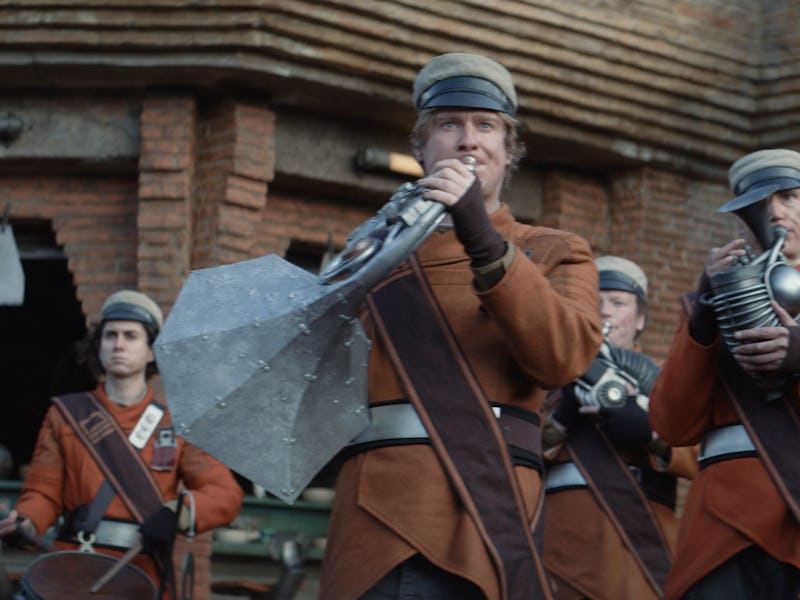The Andor finale brings us back to Star Wars' most influential music moment
The finale of Andor proved Star Wars has mastered the trick the Cantina Song introduced.

Everybody has their favorite Star Wars music moment. From that first blast of brass during the opening crawl to the triumphant formal music during the medal ceremony, John Williams made sure Star Wars would go down in musical history — and it definitely has.
But while the score of Star Wars is so iconic, there’s another element to it that often gets forgotten, or, at the very most, overlooked: source music. Andor’s finale highlighted this in its heartwrenching finale by using Maarva’s funeral procession as the score for its emotional climax. Inverse spoke to an expert about just why this was effective, and why people underestimate source music.
Source music, also known as diegetic music, means music that exists within the world of the narrative. If a character can hear it as well as the viewer, it’s diegetic, if a character can’t hear it but the viewer can, then it isn’t. “Cantina Band” is diegetic, but “Duel of the Fates” is not.
So when you think of Star Wars music, you usually think of non-diegetic music. This isn’t just a testament to John Williams’ score, it’s a commentary on the use of music in science fiction itself. “The use of diegetic music in science fiction in general is relatively rare,” Seth Mulliken, Associate Teaching Professor of Media and Screen Studies at Northeastern University tells Inverse. “The rarity of its use reflects to me how culturally complex music is to us: Music speaks to us about our culture, our identity, our spaces, and the rituals by which we shape our cultural selves and identities.”
Music is such an integral part of our culture it’s basically a language, and diegetic music that has to sound “alien” is just as jarring as hearing Huttese. But just as sound designer Ben Burtt based Huttese on the real-life language of the Indigenous Quechua peoples, John Williams based “Cantina Band” on Benny Goodman’s big band swing.
Star Wars’ use of brand-new musical stylings is essentially unique — Star Trek is connected enough to our world that Picard can still listen to classical music, and The Lord of the Rings and Game of Thrones look to centuries-old folk songs for inspiration for their diegetic stylings.
But regardless of the risk, Star Wars keeps taking stabs at cultural music within the world of Star Wars with scenes like the iconic “Yub Nub” Ewok celebration song, Lin Manuel-Miranda’s take on Cantina music in The Force Awakens, even the song that plays in Dexter Jettster’s diner in Attack of the Clones. For Mulliken, this goes to show how seriously the franchise takes worldbuilding. “Diegetic music in science fiction, especially science fiction that depicts alien or future worlds, is a very small crack,” he says, “and when we get close and peer through it, we see an enormous story-world beyond.”
The aspect that ties all these events together is clear: community. Whether around the campfire on Endor or in a greasy spoon diner on Coruscant, the characters we see around music are participating in a ritual.
The ritual of Maarva’s funeral included a full marching band.
This brings us to Andor’s finale. Maarva’s funeral is the most ritualistic event we’ve seen on Ferrix, and it brings together all of Cassian’s community. Even in the worst times, when the Imperial forces are looming all around, they gather to remember a true daughter of Ferrix.
Funerals are not just moments of remembering, they’re also moments of reckoning. It’s no coincidence that the hit musical Les Misérables also lights the spark of rebellion with a haunting song during a funeral procession that turns into a riot — when you’re not given the freedom to even celebrate your dead properly through song and contemplation, bad things happen.
Much like the Cantina Band, the instruments we see played within the band are slightly “off” versions of instruments we see in marching bands in our world. We see a flute, but it’s oddly steampunk. There’s a French horn, but its bell is geometric. The music sounds familiar but incredibly foreign at the same time.
The band’s instruments were familiar but not recognizable.
For Mulliken, the haunting power of the music is its greatest asset. “It's most interesting that before the procession starts, the Imperial forces keep saying to each other, ‘Do you hear that? Do you hear that music? Where is it coming from?’” he says. “As if the sound of music, and the fact that they can't place it in their space, is already a threat to them, a threat of cultural unity that is about to create the spark of the rebellion.”
A score can underline a powerful moment to an audience, but source music is what shows the Empire the Rebellion is here for real.
Andor is now streaming on Disney+.